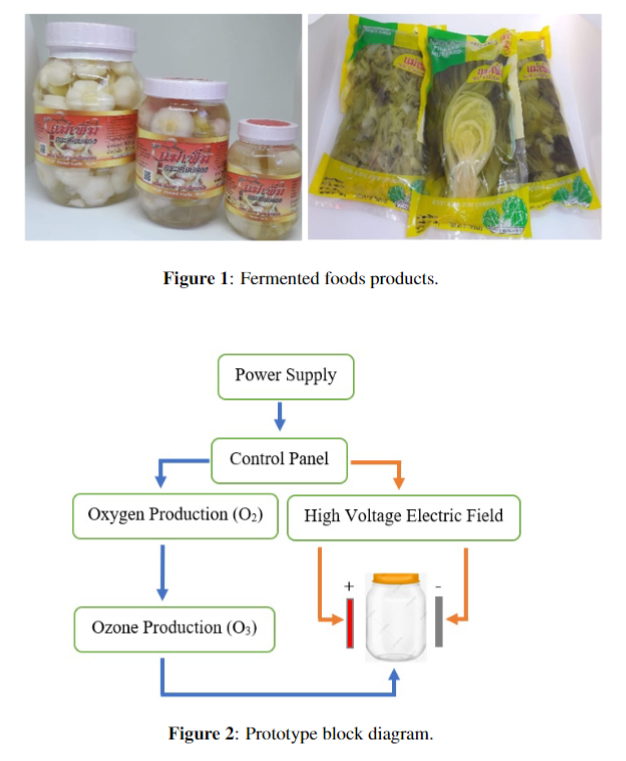Low-heat sterilization system on fruit and vegetable pickling line production in packaging with high-voltage and corona-ozone technique
Main Article Content
Abstract
This research presents a food product sterilization technique using Pulsed Electric Field (PEF) technology to inhibit microbial growth in food products and ozonation with low heat, and low power consumption can reduce the growth of bacteria in the container. This method allows the processing and preservation of food with no loss of nutritional value which preserves the flavor of the product to be more natural, safe for users, and easy to control. The test results of the prototype of a low-heat disinfection system with ozone technique in a high-pressure pulse were found that, at an ozone concentration of 4 ppm and a pressure of 50 KV, a frequency of 10 KHz at 20-35 minutes, the rate of the survival of the germ was significantly reduced: at 20 min sterilization, the growth rate was 270 cfu/ml, at 25 min, the growth rate was 160 cfu/ml. At 30 min sterilization, the growth rate was 47 cfu/ml, and at 35 min sterilization, the growth rate was 4 cfu/ml.
Article Details

This work is licensed under a Creative Commons Attribution-NonCommercial-NoDerivatives 4.0 International License.
References
Amani H. Aljahani., Microbiological and physicochemical quality of vegetable pickles, Journal of the Saudi Society of Agricultural Sciences 19 (2020) 415–421.
Abubaker Abdellah, et al., Importance and globalization status of good manufacturing practice (GMP) requirements for pharmaceutical excipients, Saudi Pharmaceutical Journal (2015) 23, 9–13.
Cherl-HoLee., Lactic acid fermented foods and their benefits in Asia, Food Control (1997) Volume 8(5-6), 259-269.
Arianna Ricci, et al., Recent Advances and Applications of Pulsed Electric Fields (PEF) to Improve Polyphenol Extraction and Color Release during Red Winemaking, MDPI Journal Beverages 4(1) (2018) 1-12.
H. Jegadeeshwar, et al., A Review on Utilization of Ozone in Food preservation. See discussions, stats, and author profiles for this publication at: https://www.researchgate.net/publication/319123327.
Abinaya Soumitra Banerjee, et al., Experimental validation on effects of pulsed electric field treatment on the sensory quality of vegetable juices, J Food Technol Pres 1(1) (2016) 56-60.
Under pressure: Meeting consumer demands with non-thermal food preservation, Available online in January 10, 2015, Available from: http://www.wiley.com.au/white-papers/under-pressuremeeting-consumer-demands-with-non-thermal-food-preservation/.
Mahendra Pa. 2017. Pulsed Electric Field Processing: An Emerging Technology for Food Preservation. Journal of Experimental Food Chemistry, ISSN:2472-0542.
Sukhuntha Osiriphun. 2019. Efficacy of ozone application Efficacy of ozone application and
disinfection treatments on pathogens in fresh-cut vegetables. Food and Applied Bioscience Journal, 2019, 7(3): 53-63


